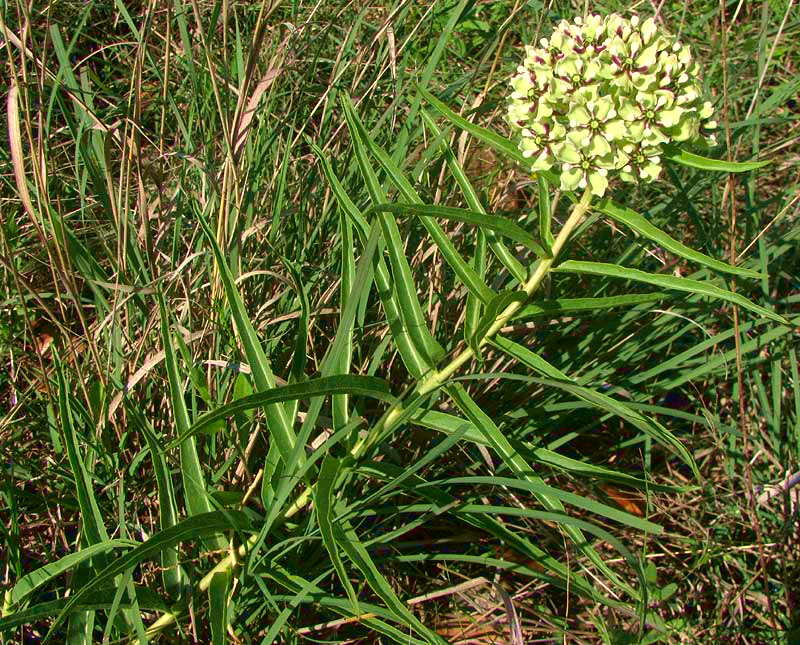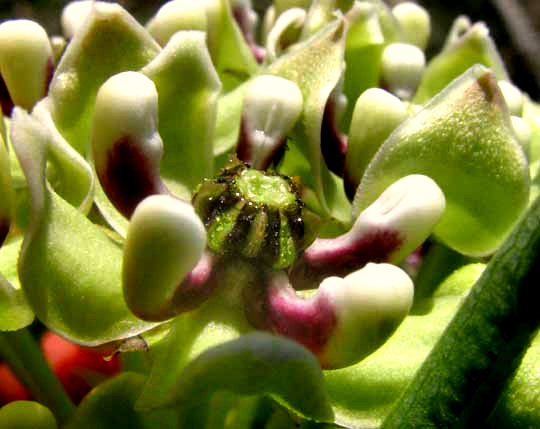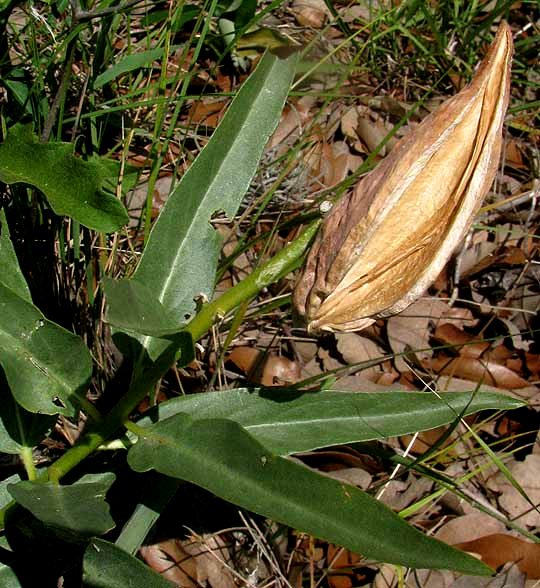Excerpts from Jim Conrad's
Naturalist Newsletter

from the the May 5, 2013 Newsletter issued from the Frio Canyon Nature Education Center in northern Uvalde County, southwestern Texas, on the southern border of the Edwards Plateau; elevation ~1750m (~5750 ft); N29.62°, W99.86°; USA
SPIDER MILKWEED
For miles the roadside just south of here had been providing the usual handful of wildflower species able to deal with summer mowings, but then suddenly a knee-high species distracted me so with its four-inch-broad (10cm), stem-terminating globe of greenish-white blossoms that I ran off the road. The spectacular plant is shown above.
With its unusual blossoms and general growth form it's obviously a milkweed, but even at first glance you can see that it's an unusual one. For one thing, milkweeds are thought of as having opposite leaves -- two leaves at each stem node -- but the upper stem on this plant bears just one leaf per node. Not many milkweed flowers are greenish, and the corolla lobes of most don't spread as widely as these flowers' do. A close-up of a blossom appears below:

Milkweed flowers have their own special, unmistakable structure. In the above picture notice that alternating with the broad, widely flaring, greenish corolla lobes are upward curving, purple-based, round-topped appendages of a kind found in few other flower types, but which are characteristic of milkweed flowers. These round-headed appendages are "hoods" and the five hoods considered together constitute the "crown." In most milkweed flowers a slender, fingerlike, sharp-topped thing, a "horn," emerges from a cleft in each hood, but this species is unusual in that no horns emerge from the hoods. Also typical of milkweed flowers is the stopper-shaped item in the flower's center. That's the "gynostegium" consisting of the fused stigma and anthers. If you want to brush up on milkweed flower structure, my page on it is at http://www.backyardnature.net/fl_milkw.htm.
Over 140 milkweed species are recognized and many are stunning and rare. Our roadside species is often called Antelope Horns, Spider Milkweed, or Green Milkweed. It's ASCLEPIAS ASPERULA, found in much of the arid US Southwest as far north as southernmost Idaho, west to southeastern California and south through most of Texas into arid northern Mexico.
Spider Milkweed, like most milkweeds, is thought to be somewhat toxic to livestock. Milkweeds are the primary food source for Monarch caterpillars. In our area Monarchs are only migratory, but the closely related Queen Butterfly, which is resident here, also uses the Spider Milkweed, both as a food source for the caterpillar and nectar source for adults.
What a pleasure to find this impressive species along the road. It was in an irregular spot where the mower must have lifted his blades.
from the July 7, 2013 Newsletter issued from the Frio Canyon Nature Education Center in the valley of the Dry Frio River in northern Uvalde County, southwestern Texas, on the southern border of the Edwards Plateau; elevation ~1750m (~5750 ft); N29.62°, W99.86°; USA
SPIDER MILKWEED FRUITING
Nowadays the Spider Milkweeds are fruiting, as shown below:

In that picture the follicle-type fruit is splitting down one side in preparation for parachuted seeds to be released into the wind. A follicle-type fruit is one that results from a simple pistil, is dry, not fleshy like a peach, and when ripe opens along one side.